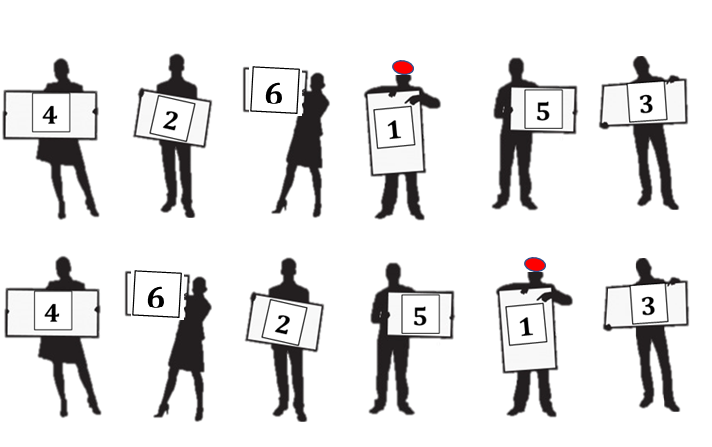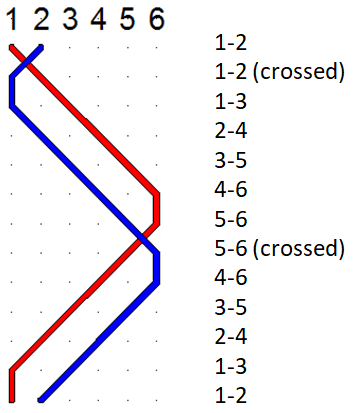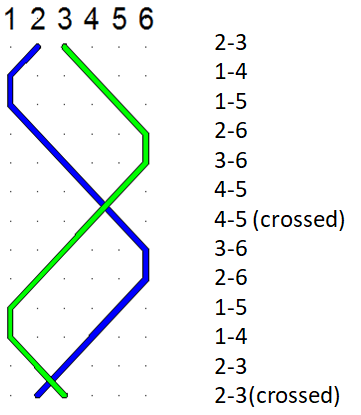The three positions
Plain hunting is the foundation of all method ringing. Once you've learnt the three plain hunt positions you can ring any method by changing from one position to another. Each method is defined by when and how often you change position in each lead. That's why it's so important to learn the three positions thoroughly. You need to be able to ring each of them automatically so that you can concentrate on these changes of position.
What is Plain Hunt?
You have already rung rounds and exercises in which you move your bells within the row, with someone calling when the changes are made. Plain Hunt is the first time that you will change the position of your bells at every row, using a set of rules to determine the change that is made, rather than being told by the conductor. Let's now look at how Plain Hunt works, sometimes known as its structure or place notation.
Starting from rounds, pairs of bells (1-2, 3-4 and 5-6) cross:

If all the bells crossed again they would just arrive back where they started, at rounds. Instead, in Plain Hunt the new bells in first and last position (the 2 and 5) stay where they are and the two inside pairs of bells cross with their new partners:

Plain Hunt consists of repeats of these two changes. This is known as a (x16) block, but don't worry too much about that at the moment. Let's look what happens when another (x16) block is rung:

If you look at the place that the treble (1) bell, with the red hat, rings in each row, you'll start to see a pattern, this is the plain hunt pattern. All the bells ring this pattern starting at a different place in rounds at the beginning.
Repeating the operation of alternating all three pairs crossing and then only the two internal pairs crossing will eventually generate rounds and what ringers call a course of Plain Hunt will have been rung.
The above changes could be written as:
X X X
I X X I
X X X
I X X I etc...
Write it out for yourself now with all the numbers written in:
1 2 3 4 5 6
2 1 4 3 6 5
2 4 1 6 3 5
4 2 6 1 5 3
4 6 2 5 1 3 etc...
Keep going till you are back at rounds.
Now – how can we ring this thing called plain hunt on handbells? Happily plain hunting two handbells is easier than it sounds. You need a group of three interested people and a set of handbells. On six bells (minor) there are only three patterns for your left and right hands to master. These are called a coursing pair of bells, an opposites pair and a 2-3 pair. Reach for your squared paper and 2 different coloured pens.
Plain Hunt on six bells
There are two ways of learning the three positions:
- By learning the two places that your bells ring in each row.
- By learning the first place that you ring in a row and the gap you leave before ringing your second bell.
Have a go at both and see which one works better for you.
Be aware that if both bells are hunting in
the same direction then the gap between them remains constant. The gap
changes by one if one bell is hunting and the other is making a place.
The gap between them shrinks by two if they are hunting towards each
other, and increases by two every time they hunt in opposite directions.
Coursing position

This is the pattern rung by 1-2 and by 5-6. It is the easiest position to learn and ring. Remember:
- Know which hand is closer to the front in every change (blue or red).
- Know what place that hand is striking in.
- Leave a gap and sound the other hand – signature characteristic of a coursing pair – or learn the number pairs by rote.
- Meet and cross in 1/2 and 5/6.
- You start and end by crossing your bells.
You will recognise that the pattern of a gap of a single bell only alters when one of your pair is called upon to lead or lie. When both bells are hunting the gap of one is maintained.
In the first half of the
course you must be concentrating on the 2, after the reverse rounds at
the halfway point you must then concentrate on the treble.
Always concentrate on the first of your bells to strike, count its place, leave a gap and sound the other hand.
Watch the trebles (1-2) ring Plain Hunt in this video. Then recite along with the ringing:
- Either the places they ring in – cross, 1/3, 2/4, 3/5, 4/6/ meet, cross, 4/6, 3/5, 2/4, 1/3, meet
- Or the gaps between them – cross, 1 and 1 between, 2 and 1 between, 3 and 1 between, 4 and 1 between, meet, cross, 4 and 1 between, 3 and 1 between, 2 and 1 between, 1 and 1 between, meet.
Now watch the tenors (5-6) who also ring the coursing position but starting in a different place. Recite what they ring.
Opposites position

This is the pattern rung by 3-4. It is the second easiest position to learn and ring. The pattern is akin to an object and its reflection with a mirror running down the centre. When one bell sounds in 3rd place the other is in 4th (either side of the mirror). When one bell sounds in 2nd place (one away from the front) the other sounds in 5th (one away from the back), when one bell sounds first the other is last.
In the opposites position the bells meet and cross in 3/4.
You need to keep track of which of your pair is closest to the front, what place it is in and then ring the other bell in the appropriate place. If you have counted the first of your bells to be in 2nd place then the other bell must ring in 5th, if however your first bell is in 3rd then the other bell must be in 4th place.
Do not try to keep track of the position of both bells and to hunt them both – rather keep track of the place of the first of your pair to strike and then simply ring the other bell as a reflection of the first.
Remember which bell is closest to the front of your pair (this is the one you are counting) and which is the reflection. Loudly count 3rd (quietly think 4th for the other hand). Loudly count 2nd (quietly think 5th for the other hand). Loudly count 1st (quietly think last for the other hand) etc.
Watch the 3-4 ring Plain Hunt in this video. Then recite along with the ringing:
- Either the places the bells ring in – cross, 2/5, 1/6, 1/6, 2/5 meet, cross, 2/5, 1/6, 1/6, 2/5, meet.
- Or the gaps between them – cross, 2 between you, 3 between you, 3 between you, 2 between you, meet, cross, 2 between you, 3 between you, 3 between you, 2 between you, meet.
The 2/3 position

And finally, you are ready to look at the look at the last of the three positions, the 2/3 position. It does not relate to any of the traditional pairs, 1-2, 3-4 or 5-6 that ringers ring. It is the position rung if a ringer rang the 2-3 or 4-5.
In the 2/3 position, the bells meet and cross in 2/3 and 4/5.
This is the position in which the bells both hunt in the same direction (in which case the gap between them remains constant) AND hunt towards or away from each other (in which case the gap between them shrinks or increases by 2).
Watch the 3-4 ring Plain Hunt in this video. Note however that the ringing does not start or finish with rounds – 1 2 3 4 5 6 – but with the row – 2 3 4 5 6 1 – which means that the person ringing 3-4 starts by striking in 2nd and 3rd place, so they are ringing the 2-3 position. Sounds complicated but you'll get it when you watch the video.
Recite along with the ringing:
- Either the places the bells ring in ... cross, 1/4, 1/5, 2/6, 3/6 meet, cross, 3/6 2/6, 1/5, 1/4, meet.
- Or the gaps between them ... cross, 2 between you, 3 between you, 3 between you, 2 between you, meet, cross, 2 between you, 3 between you, 3 between you, 2 between you, meet.
Hunting positions
» Plain Hunt
Practising the positions
It is important to practise these positions until they become automatic. This requires you to do your homework.
» Practising on your own
Reciting numbers or mantras or twiddling your thumbs whenever you have a spare moment may feel a bit strange, but it works! Online ringing simulators also help as they will introduce you to the rhythm of the different positions.